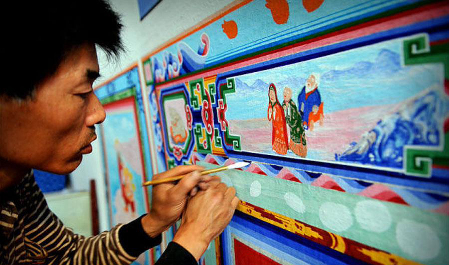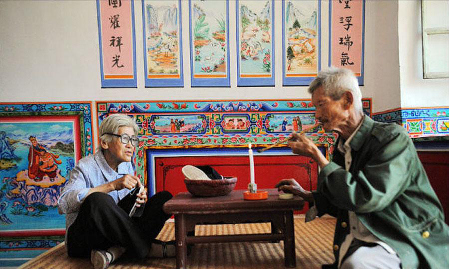
The Kangweihua is a painting drawn around the walls of a Kang, brick-built bed widely used in northern China. Such a bed has a fireplace installed below, creating a warm environment in the winter. Kangweihua helps keep the mud walls’ surface from cracking and falling onto the unsuspecting sleepier, keep the quilt and clothes tidy, and also, decorate the bedroom. It was common in the villages of Shanxi province up until the 1980s.?


The Kang bed was present in almost every household due to the cold winters?in northern China. The walls around the Kang are kept hot from the fire, resulting in dusty dry wall surfaces. To remedy this, people applied a kind of special white mud and glue mixture to the wall. The decoration patterns were then drawn on the surface. In this way, the first Kangweihuas appeared.
Later the white mud was covered with colored patterns, and sealed with Tung oil. The Tung oil made it easy to clean the wall with a wet rag, which made it much easier to clean than earlier versions of the Kangweihua.
As the drawing technique developed, many professional painters were engaged to do the painting job, turning the Kangweihua from a practicality into an object of art.
The subject matter of the Kangweihua usually focuses on local folklore, traditional dramas, historical figures, beautiful landscape, plants, and flora and fauna. The structure of the Kangweihua is simple and uncomplicated, centered on a single subject.
There are three main types of Kangweihua. One is finely drawn, used in the bedrooms of young couples. Another form is used especially for the bedrooms of elderly people. The most common Kangweihuas have a simple pattern and style.
The pigment used in the Kangweihua is made by the artists themselves and remain vivid without fading for a long time.
Kangweihuas were mostly made by folk artisans, the craft passed on from generation to generation. Since the 1980s, living customs have changed, and Kang, along with their Kangweihuas are disappearing from village houses.